The demand for fruit pectin in Japan is expected to grow from USD 57.1 million in 2025 to USD 86.2 million by 2035, reflecting a CAGR of 4.2%. Fruit pectin, a natural gelling agent used extensively in the food industry for the production of jams, jellies, and confectionery products, continues to experience growth driven by the increasing consumer preference for natural and clean-label ingredients. With growing interest in healthier alternatives to artificial additives, pectin is being increasingly used in the production of sugar-free and low-calorie food products, further supporting its demand. The continued shift towards functional foods, including those with enhanced digestive health benefits, will also boost the consumption of fruit pectin as an ingredient in a variety of processed foods.
Additionally, the rise of plant-based diets and clean eating trends is further driving the demand for natural food ingredients like fruit pectin. As consumer preferences continue to evolve, manufacturers are focusing on creating innovative pectin-based products that meet consumer demands for health-conscious and sustainable foods. The expanding use of fruit pectin in bakery products, dairy, and beverages also contributes to its growing demand in Japan's diverse food market.
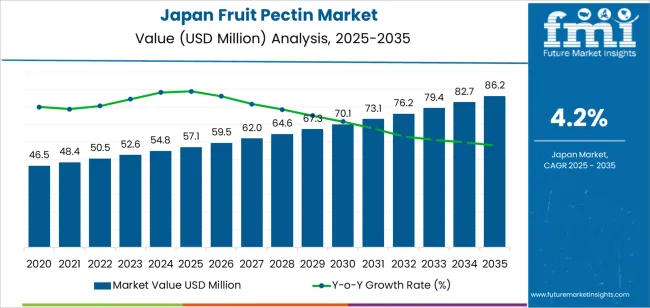
From 2025 to 2030, the market for fruit pectin in Japan will grow from USD 57.1 million to USD 70.1 million, contributing USD 13 million in value. During this period, the volume growth will be the primary driver of demand, as the expansion of consumer adoption for pectin-based products increases. This phase will witness an increase in the manufacturing capacity and distribution channels for fruit pectin products, driven by higher consumption in the confectionery, jams, and beverages sectors. The growth will be mainly driven by rising demand for natural, functional food ingredients, with volume growth accounting for the majority of the overall increase in market size. However, the price growth will remain relatively stable, with only modest increases due to supply chain factors and ingredient sourcing challenges.
From 2030 to 2035, the market will grow from USD 70.1 million to USD 86.2 million, adding USD 16.1 million in value. During this phase, price growth will begin to contribute more significantly to the market's overall expansion. As raw material costs for pectin production increase, manufacturers will incorporate price increases into their products to offset higher production expenses. This period will also be marked by a rise in premium pectin-based products, where higher prices reflect the quality and innovation of new pectin-based offerings, catering to the growing demand for specialty foods and natural ingredients. Despite the modest increase in volume, the price growth will account for a larger share of the market’s expansion as demand stabilizes and premium product offerings gain traction.
| Metric | Value |
|---|---|
| Industry Sales Value (2025) | USD 57.1 million |
| Industry Forecast Value (2035) | USD 86.2 million |
| Industry Forecast CAGR (2025 to 2035) | 4.2% |
Demand for fruit pectin in Japan is increasing as food and beverage manufacturers turn toward clean label and natural ingredients in products such as jams, jellies, confectionery fillings, dairy desserts and beverages. The market in Japan is projected to grow at a compound annual growth rate (CAGR) of around 6.1 % from 2025 onward, as noted in recent ingredient industry analyses.
Another contributing factor is the rising consumer preference for functional foods, high quality formulations and premium localisation in Japan. Ingredient innovation, such as modified pectin grades for low sugar and reduced fat applications, supports broader uptake. At the same time, the high standard of food manufacturing infrastructure in Japan and growth of fruit based product categories support this demand. Challenges include fluctuations in raw material supply (particularly citrus peels), higher cost of specialty pectin grades and competition from alternative hydrocolloids. Despite these constraints, the combination of functional ingredient demand, clean label trends and product diversification suggests that demand for fruit pectin in Japan will continue to grow.
The demand for fruit pectin in Japan is primarily driven by form and end-user segment. The leading form is original dry, capturing 61.2% of the market share, while the dominant end-user segment is the health care industry, accounting for 42.3% of the demand. Fruit pectin is widely used as a gelling agent, stabilizer, and thickening agent in various industries, with particular demand in food, beverage, and healthcare applications. The increasing focus on health-conscious consumption and the demand for natural ingredients are fueling growth in this market.
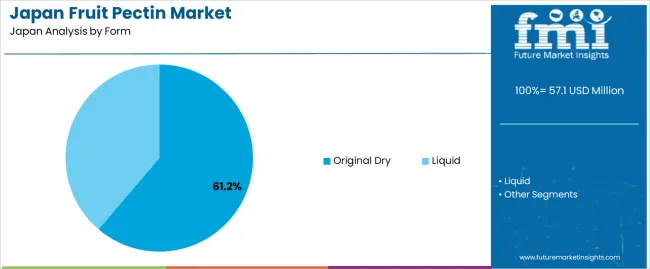
Original dry fruit pectin leads the market in Japan, holding 61.2% of the demand. Dry pectin is favored for its ease of storage, longer shelf life, and the convenience it offers in food processing, particularly for making jams, jellies, and other gelled products. It is also easier to handle and measure compared to liquid pectin, making it a preferred choice in both industrial and domestic applications.
The demand for dry pectin is largely driven by its widespread use in the food and beverage industry for its gelling properties. As natural ingredients and clean-label products become more desirable among consumers, dry fruit pectin remains an essential component in producing jams, fruit preserves, and other gel-based food products. The growing popularity of homemade and artisanal food production, combined with the increasing preference for natural gelling agents over synthetic alternatives, ensures that dry fruit pectin will continue to be a dominant form in Japan’s market.

The health care industry is the largest end-user segment for fruit pectin in Japan, accounting for 42.3% of the demand. Fruit pectin is valued in the health care sector for its dietary fiber content, particularly its role in digestive health and weight management. Pectin is known to support healthy cholesterol levels, aid in digestion, and provide natural detoxification benefits, which is driving its increasing use in dietary supplements, functional foods, and pharmaceuticals.
The demand from the health care industry is driven by the growing consumer interest in natural health products and dietary supplements that support wellness. As pectin is recognized for its health benefits and is considered a natural and safe ingredient, its use in health-focused products such as fiber supplements, laxatives, and digestive aids is expanding. With the increasing focus on health and nutrition in Japan, the health care industry will continue to be a key driver of fruit pectin demand.
Demand for fruit pectin in Japan is driven by the dual needs of product functionality and clean label positioning across food and beverage formulations. Japanese manufacturers of jams, confectionery, dairy alternatives and fruit based beverages rely on pectin for gelation, stabilisation and mouthfeel enhancement in formulations. At the same time, cost pressures, tight regulatory standards and strong local preferences for texture and taste moderate the pace of new adoption. These interacting forces shape how the fruit pectin market is evolving in Japan.
Several factors support growth of fruit pectin use in Japan. First, rising consumption of fruit based foods, ready to eat desserts and premium jams drives need for gel forming and stabilising agents like pectin. Second, consumer demand for clean label and plant based ingredients boosts interest in pectin as a natural alternative to synthetic stabilisers. Third, expansion of functional foods and beverages incorporating fruit extracts, fibre and fortified systems uses pectin as a vehicle for texture and stability. Fourth, manufacturers’ reformulation efforts to reduce sugar and fat in indulgence style products benefit from pectin’s ability to maintain desired texture in lower sugar systems.
Despite favourable drivers, several restraints hinder expansion of pectin demand in Japan. Price volatility of raw materials-such as citrus peels or sugarcane by products used for pectin extraction-can add cost and limit competitiveness against alternatives. Also, some food formulators may choose other hydrocolloids or gelling agents when cost, availability or functionality criteria differ, which reduces pectin’s addressable share. Taste and texture expectations in the Japanese market are exacting, so poor performance of pectin based systems may inhibit adoption. Lastly, regulatory and labeling requirements for health functional claims and ingredient sourcing may increase supplier burden and slow product launches.
Important trends shaping the Japanese market include development of speciality pectin grades tailored for reduced sugar formulations, plant based dairy alternatives and clean label dessert lines. Suppliers are offering citrus derived and apple derived pectins with enhanced gel strength and improved solubility to meet Japanese texture preferences. There is also growing integration of pectin with fruit fibres and prebiotic functionality to support digestive health positioning. In addition, Japanese ingredient buyers increasingly value traceability, sustainable sourcing and minimal processing in pectin supply chains, aligning with broader consumer and regulatory sustainability drives.
The demand for fruit pectin in Japan is driven by its widespread use in the food and beverage industry, particularly in the production of jams, jellies, fruit preserves, and other processed food products. As a natural gelling agent, pectin plays a crucial role in enhancing the texture, stability, and shelf life of fruit-based products. Additionally, with the growing consumer preference for clean-label and natural ingredients, pectin’s natural origin from fruits makes it an attractive option for manufacturers aiming to meet the increasing demand for healthier and more transparent food products.
The rise of fruit-based snacks, beverages, and functional foods, along with the growing awareness of the health benefits of natural products, has further contributed to the demand for fruit pectin. Moreover, Japan's emphasis on high-quality food production, along with its rigorous food safety standards, ensures that pectin remains a key ingredient in food manufacturing. Regional variations in demand are influenced by factors such as food production activity, local dietary preferences, and the availability of raw materials. Below is an analysis of the demand for fruit pectin across different regions in Japan.
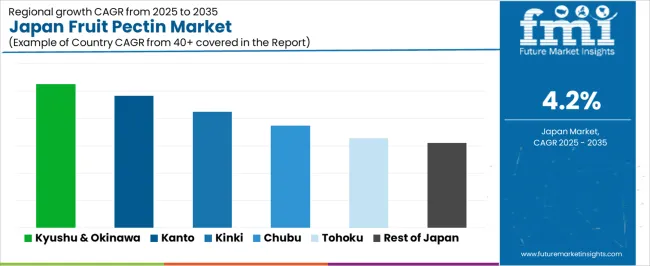
| Region | CAGR (%) |
|---|---|
| Kyushu & Okinawa | 5.3 |
| Kanto | 4.8 |
| Kinki | 4.2 |
| Chubu | 3.7 |
| Tohoku | 3.3 |
| Rest of Japan | 3.1 |
Kyushu & Okinawa leads the demand for fruit pectin in Japan with a CAGR of 5.3%. This can be attributed to the region’s strong agricultural base, particularly in fruit production. Kyushu & Okinawa are known for cultivating a variety of fruits, which support the growing demand for pectin in the local food manufacturing industry. The region's increasing focus on natural and organic food products, coupled with a cultural preference for high-quality, locally produced food ingredients, further contributes to the rising demand for fruit pectin.
The growing interest in healthier food options, including fruit-based products and clean-label ingredients, has led to an increase in the use of fruit pectin in jams, beverages, and snacks. As Kyushu & Okinawa continues to focus on sustainable agriculture and natural ingredients, the demand for fruit pectin is expected to remain high.
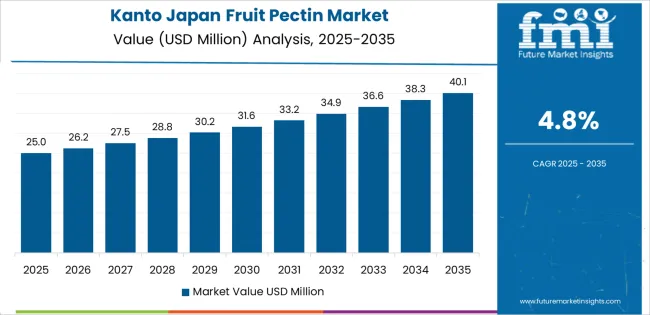
Kanto shows strong demand for fruit pectin with a CAGR of 4.8%. As Japan’s economic and industrial hub, Kanto, which includes Tokyo and surrounding areas, has a large food manufacturing sector that increasingly focuses on producing natural, health-conscious, and functional food products. The demand for fruit pectin is driven by the region's growing focus on fruit-based snacks, jams, beverages, and other processed foods that require gelling agents for texture and stability.
In Kanto, consumer interest in clean-label and organic products has grown significantly, further boosting the demand for fruit pectin, which aligns with the region's preference for natural ingredients. Additionally, the region's strong retail infrastructure, with supermarkets, health food stores, and online retailers offering a wide range of fruit-based products, ensures the widespread availability of fruit pectin and pectin-containing products.
Kinki, with a CAGR of 4.2%, shows steady demand for fruit pectin. The region, which includes major cities like Osaka, Kyoto, and Kobe, has a rich food culture with a strong emphasis on quality and innovation. Kinki’s food manufacturing sector, particularly in the production of fruit preserves, jams, and beverages, has contributed to the steady demand for fruit pectin.
While the growth rate is slightly slower compared to Kyushu & Okinawa and Kanto, the steady demand is driven by the region’s commitment to producing high-quality food products that meet consumer expectations for taste, texture, and health benefits. The increasing consumer interest in functional and fruit-based foods further supports the demand for fruit pectin, and as more food manufacturers in Kinki adopt natural ingredients, this market will continue to see gradual growth.

Chubu demonstrates moderate growth in the demand for fruit pectin with a CAGR of 3.7%. The region, known for its industrial base, is increasingly witnessing a shift toward more health-conscious eating habits, including the growing demand for fruit-based products. While Chubu has a strong food industry, particularly in processed foods and beverages, its adoption of fruit pectin is growing at a slower pace compared to more urbanized regions like Kanto.
The region’s increasing focus on healthier, natural food ingredients, combined with a rise in the production of fruit-based snacks and beverages, is driving the demand for fruit pectin. As consumer awareness of the benefits of natural and clean-label ingredients continues to grow, the demand for fruit pectin in Chubu is expected to rise at a moderate pace.
Tohoku, with a CAGR of 3.3%, and the Rest of Japan, with a CAGR of 3.1%, show slower growth in the demand for fruit pectin. These regions tend to have more traditional food cultures and are less focused on innovative food products like fruit-based snacks and beverages that often require gelling agents. The adoption of fruit pectin is slower due to fewer food manufacturing facilities in these areas and a lower concentration of industries that produce processed foods.
However, as awareness of health and wellness continues to spread across Japan and the demand for natural ingredients grows, the adoption of fruit pectin is expected to increase gradually in these regions. The slow but steady growth in demand reflects the gradual shift in consumer preferences towards cleaner, more functional food options.
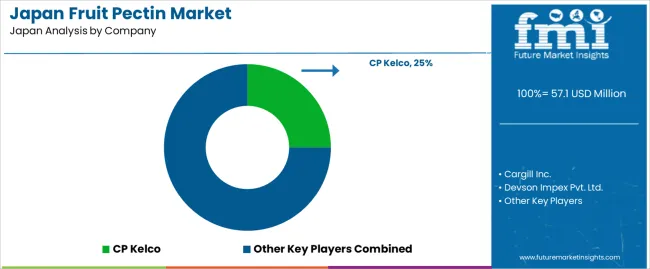
The demand for fruit pectin in Japan is growing, driven by its widespread use in the food and beverage industry as a natural gelling agent, stabilizer, and thickener in products like jams, jellies, fruit-based desserts, and beverages. Companies like CP Kelco (holding approximately 25% market share), Cargill Inc., Devson Impex Pvt. Ltd., Nestlé S.A., and Danone S.A. are key players in this market. As consumers increasingly prefer clean-label and natural ingredients, the demand for pectin, which is derived from fruits and used in a variety of food applications, continues to rise.
Competition in the fruit pectin industry is primarily driven by product quality, sourcing, and customization. Companies are focusing on offering pectin products that deliver superior gelling performance, texture, and stability while meeting the growing consumer demand for natural and organic ingredients. Another area of competition is the ability to offer pectin solutions that are tailored for specific applications, such as low-sugar or sugar-free products, catering to the health-conscious consumer. Additionally, sustainability is a key consideration, with companies exploring eco-friendly sourcing and manufacturing processes for pectin production. Marketing materials often highlight features such as gelling strength, versatility in food applications, and clean-label certifications. By aligning their offerings with the increasing demand for natural, sustainable, and high-performing ingredients, these companies aim to strengthen their position in Japan’s fruit pectin market.
| Items | Details |
|---|---|
| Quantitative Units | USD Million |
| Regions Covered | Japan |
| Form | Original Dry, Liquid |
| End-User | Health Care Industry, Food and Beverage, Personal Care and Cosmetic Industry |
| Application | Food Supplement, Bakery Toppings and Fillings, Beverages, Dairy & Frozen Products, Pharmaceuticals |
| Function | Thickeners, Gelling Agents, Stabilizer, Fat Replacer, Detoxification Agents |
| Key Companies Profiled | CP Kelco, Cargill Inc., Devson Impex Pvt. Ltd., Nestlé S.A., Danone S.A. |
| Additional Attributes | The market analysis includes dollar sales by form, end-user, application, and function categories. It also covers regional demand trends in Japan, particularly driven by the increasing need for fruit pectin in the food and beverage industry, along with its growing use in health care and personal care products. The competitive landscape highlights key players focusing on innovations in pectin production and its various functionalities in different applications. Trends in the increasing demand for natural and functional ingredients such as pectin, particularly in clean-label and health-conscious products, are explored, along with advancements in production technologies. |
The demand for fruit pectin in Japan is estimated to be valued at USD 57.1 million in 2025.
The market size for the fruit pectin in Japan is projected to reach USD 86.2 million by 2035.
The demand for fruit pectin in Japan is expected to grow at a 4.2% CAGR between 2025 and 2035.
The key product types in fruit pectin in Japan are original dry and liquid.
In terms of end-user, health care industry segment is expected to command 42.3% share in the fruit pectin in Japan in 2025.






Our Research Products

The "Full Research Suite" delivers actionable market intel, deep dives on markets or technologies, so clients act faster, cut risk, and unlock growth.

The Leaderboard benchmarks and ranks top vendors, classifying them as Established Leaders, Leading Challengers, or Disruptors & Challengers.

Locates where complements amplify value and substitutes erode it, forecasting net impact by horizon

We deliver granular, decision-grade intel: market sizing, 5-year forecasts, pricing, adoption, usage, revenue, and operational KPIs—plus competitor tracking, regulation, and value chains—across 60 countries broadly.

Spot the shifts before they hit your P&L. We track inflection points, adoption curves, pricing moves, and ecosystem plays to show where demand is heading, why it is changing, and what to do next across high-growth markets and disruptive tech

Real-time reads of user behavior. We track shifting priorities, perceptions of today’s and next-gen services, and provider experience, then pace how fast tech moves from trial to adoption, blending buyer, consumer, and channel inputs with social signals (#WhySwitch, #UX).

Partner with our analyst team to build a custom report designed around your business priorities. From analysing market trends to assessing competitors or crafting bespoke datasets, we tailor insights to your needs.
Supplier Intelligence
Discovery & Profiling
Capacity & Footprint
Performance & Risk
Compliance & Governance
Commercial Readiness
Who Supplies Whom
Scorecards & Shortlists
Playbooks & Docs
Category Intelligence
Definition & Scope
Demand & Use Cases
Cost Drivers
Market Structure
Supply Chain Map
Trade & Policy
Operating Norms
Deliverables
Buyer Intelligence
Account Basics
Spend & Scope
Procurement Model
Vendor Requirements
Terms & Policies
Entry Strategy
Pain Points & Triggers
Outputs
Pricing Analysis
Benchmarks
Trends
Should-Cost
Indexation
Landed Cost
Commercial Terms
Deliverables
Brand Analysis
Positioning & Value Prop
Share & Presence
Customer Evidence
Go-to-Market
Digital & Reputation
Compliance & Trust
KPIs & Gaps
Outputs
Full Research Suite comprises of:
Market outlook & trends analysis
Interviews & case studies
Strategic recommendations
Vendor profiles & capabilities analysis
5-year forecasts
8 regions and 60+ country-level data splits
Market segment data splits
12 months of continuous data updates
DELIVERED AS:
PDF EXCEL ONLINE
Demand Signal Repository Solutions Market Size and Share Forecast Outlook 2025 to 2035
Demand Side Management Market Size and Share Forecast Outlook 2025 to 2035
Demand Response Market Analysis - Size, Share, and Forecast Outlook 2025 to 2035
North America Shipping Supplies Market Trends – Innovations & Growth 2024-2034
Demand of Kozani Saffron in Greece Analysis - Size, Share & Forecast 2025 to 2035
Demand of No-acid Whey Strained Dairy Processing Concepts in European Union Size and Share Forecast Outlook 2025 to 2035
Demand for Bronte Pistachio in Italy Analysis - Size, Share & Forecast 2025 to 2035
Demand and Trend Analysis of Gaming Monitor in Western Europe Size and Share Forecast Outlook 2025 to 2035
Demand and Trend Analysis of Gaming Monitor in Korea Size and Share Forecast Outlook 2025 to 2035
Demand and Trend Analysis of Gaming Monitor in Japan Size and Share Forecast Outlook 2025 to 2035
Glycine Soja (Soybean) Seed Extract Market Size and Share Forecast Outlook 2025 to 2035
Demand and Trend Analysis of Yeast in Japan - Size, Share, and Forecast Outlook 2025 to 2035
Demand of Pistachio-based desserts & ingredients in France Analysis - Size, Share & Forecast 2025 to 2035
Western Europe Men’s Skincare Market Analysis – Forecast 2023-2033
Demand and Trends Analysis of Stevia in Japan Size and Share Forecast Outlook 2025 to 2035
Japan Women’s Intimate Care Market Trends – Growth & Forecast 2024-2034
Demand and Trend Analysis of Fabric Stain Remover in Korea Size and Share Forecast Outlook 2025 to 2035
Demand and Sales Analysis of Paper Cup in Korea Size and Share Forecast Outlook 2025 to 2035
Demand and Sales Analysis of Paper Cup in Western Europe Size and Share Forecast Outlook 2025 to 2035
Demand of MFGM-enriched Powders & RTDs in European Union Size and Share Forecast Outlook 2025 to 2035

Thank you!
You will receive an email from our Business Development Manager. Please be sure to check your SPAM/JUNK folder too.
Chat With
MaRIA